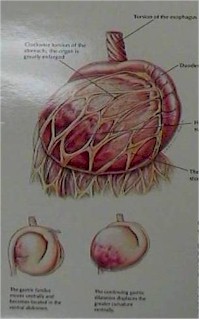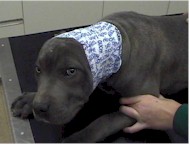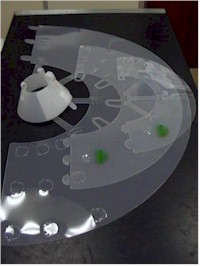Common Sense First Aid for Dogs
|
|
|
|
A guide to what to do in an emergency...
|
|
The four rules of first aid Do not panic! Maintain the airway: mainly through stretching out the neck carefully and removing anything from the mouth, if possible. Control bleeding (See below under ‘haemorrhage’) Contact the vet
Handling injured animals Brief examination and first treatment
A stretcher can made of a plank of wood for instance. The latter is especially important if there is any suspicion of spinal injury or the dog is collapsed or severely injured. Be as quick as you can but do not take any unnecessary risks. |
|
Here are some situations you might encounter at club or at a show.
This can lead to suffocation.
Treatment - Try to remove the ball with your fingers initially, but beware for bites! Pressure from behind the ball sometimes helps. If all else fails, a corkscrew can be carefully inserted into the ball to pull it out.
 If
you suspect that your dog may suffer from bloat, the best advice is to go and see the vet
immediately!
If
you suspect that your dog may suffer from bloat, the best advice is to go and see the vet
immediately!
Symptoms may include a swollen abdomen, trying to vomit, collapse, pale mucous membranes, abdominal discomfort.
Burns are the result of dry heat, extreme cold, corrosive materials or electricity. Scalds are the result of moist heat, e.g. steam.
Treatment - The best treatment for both is cooling with water, keeping the dog warm (e.g. with blankets/towels), dressing the wounds (sterile pads or cling film), and preventing too much movement in the area of the wound (sometimes splinting is necessary for this).
Complications of burns can be shock, infection or difficulty breathing (smoke!). Do not use creams, powders and lotions to put on burns!
 Bleeding:
This is often the result of cuts, bites, scratches etc. They often look worse than they are,
especially as the dog will shake its head and spread the blood around.
Bleeding:
This is often the result of cuts, bites, scratches etc. They often look worse than they are,
especially as the dog will shake its head and spread the blood around.
Treatment - Try and stop the bleeding (see above) and put a bandage on if possible. Prevent rubbing of the ear. A good way to prevent the ear flap being flapped around is by putting a cut up pair of tights on the dog’s head.
Aural haematomas are swellings of the ear flap, these are not an emergency.
Foreign bodies are often seen in the ear, mostly grass seeds (awns) in the summer months. These are intensely painful and need to be removed, often under general anaesthetic, by your vet.
If a dog has an epileptic fit or similar, the best thing to do is to put the dog in a quiet and darkened room and prevent it from harming itself. Clear the mouth if necessary, but beware of biting! If the dog stays in a fit for more than five minutes (this is a very long time!) ring the vet. Most dogs will come out of a fit within a few minutes. Stay calm!
Swollen eyelids are often the result of allergic reactions (e.g. insect bites) or foreign bodies (e.g. grass seeds, splinters etc.).
Treatment - Prevent rubbing by putting on an Elizabethan collar. Rinse the eye with copious amounts of saline solution (best is the ophthalmic solution used for contact lenses, otherwise make your own by dissolving a teaspoon of household salt in a pint of clean water) or alternatively water.
Corneal injuries are often the result of scratches, bites and foreign bodies (e.g. thorns).
Treatment - Flushing the eye is best (see above). Also prevent rubbing (see above).
Eye prolapse is a very serious condition, mostly the result of blunt trauma such as a road traffic accident. It happens mainly in short nosed breeds, such as Pugs etc.
Treatment - The most important thing to do is to keep the eyeball moist, e.g. with saline solution, oil, butter or similar, and to seek veterinary attention urgently! Prevent rubbing (see above).
Fractures can be open (broken skin) or closed (skin intact). Signs can include pain, swelling, loss of function (lame, leg held up), deformity or ‘crepitus’ (grating feeling/sound).
Treatment is based on controlling bleeding if open and minimising movement of the part of the body involved. Handle as little as possible and provide support. This can be achieved by using a bandage or a splint. Splints can be made from wood, metal, plastic, rolled up newspaper or anything else which is stiff).
Dogs can bleed from arteries (bright red and pumping), from veins (darker red, not pumping), from capillaries (oozing) and from a mixture of these. Bleeding can be either external from wounds, nose, bowel, mouth etc. or internal from muscles, chest, abdomen etc.).
Treatment can be by four different methods:-
Direct pressure: Put your finger or hand directly on the bleeding wound
Pad and pressure bandage: Use anything clean you can find, such as a towel, a piece of clothing etc.
Pressure on ‘pressure points’: This is where the artery, supplying the body part it is bleeding from, runs. Not many people will know where to apply pressure though.
Using a tourniquet: This is something to put pressure on the artery above the point of bleeding. Different things can be used, such as elastic bands, belts, scarves etc. Never leave a tourniquet on for more than 30 minutes!
This is an abnormally high body temperature and is more common in short nosed dogs and long haired dogs, but can happen in all breeds. It is of course most common in the summer months. Dogs will pant heavily and can show drooling, restlessness, unsteadiness, collapse and even coma and death!
Treatment - First aid treatment is geared towards cooling down the dog. Do this with water (preferably running water) or wet blankets. Your vet may use a cold intravenous drip to further cool down the patient. Clear the mouth if necessary. Do not immerse the patient in cold water as this can cause shock!
This is an abnormally low body temperature and the opposite of hyperthermia. It happens mainly to young or very small dogs.
Treatment - First aid treatment is geared towards slowly warming up the dog. To this purpose you can use massage, cover the dog up, or use a hot water bottle, a heat lamp or a warmed up drip (at the vets).
Nails can break off and cause pain and bleeding. The bleeding will usually stop within minutes.
Treatment - If this does not happen, you can try and stop the bleeding by holding cold wet cotton wool against the nail(bed). It is not really an emergency.
|
Nose Bleeds |
This can be due to trauma, foreign bodies (e.g. grass, wood, metal etc), blood clotting problems or a tumour.
Treatment - Initial treatment will be with a cold compress on the nose and muzzle, dog permitting. It will often look a lot worse than it actually is!
|
Poisoning |
Most poisonings are the result of accidents, overdose, unusual reactions, carelessness or ignorance, but some are malicious! There are several categories of poisons:
|
Type of Poison |
Beware of |
| Medicines | Sedatives, painkillers, heart tablets etc. |
| Pesticides | Weed killer, slug pellets, snail bait, certain flea treatments (e.g. those containing organophosphates) etc. Household chemicals, incluyding rat/mouse poison, antifreeze etc. |
| Plants | Not often seen, including deadly nightshade, kale, rape, white bryony, cherry laurel, ergot, hemlock, dumb cane, foxglove, egg plant, horsetails, St John's wort, rhododendron, laburnum, linseed, dog's mercury, oak, philodendron, bracken fern, ragwort, rhubarb, spurge laurel, sugar beet, black bryony, yew, tomato, tobacco, winter cherry, woody nightshade and possibly others |
| Insect stings | Wasps, bees etc. |
| Snake bites | Adders |
Treatment: the most important thing to do is to try and identify the actual poison! If you have the bottle/packaging etc take it to your vet! Sometimes a specific antidote can be given.
 Prevention
of further absorption of the poison can be achieved in several ways:
Prevention
of further absorption of the poison can be achieved in several ways:
Removing the source: Wash the dog’s coat if the poison is on the animal, putting on an Elizabethan collar or a bandage or a T-shirt.
Induce vomiting: Use washing soda or ordinary kitchen salt directly in the mouth or on the back of the tongue. BUT: do not use this method if the poison could have been something corrosive or a sedative, when the dog is fitting or when it was more than four hours ago than the dog was poisoned!
Gastric lavage: This can only be done by your vet. It means washing out of the stomach through a stomach tube.
Prevention of absorption through the stomach or intestinal wall, e.g. through the use of activated charcoal or by giving a laxative.
In many cases, it is unknown what poison has been taken and, therefore, the dog will often be treated symptomatically, which means the vet will look at what symptoms your dog displays and treat it accordingly.
|
Stroke & Vestibular Syndrome |
This condition is caused by damage to the balance organ in the inner ear. It affects mainly older dogs, who will show a head tilt, loss of balance and sometimes circling. In some cases the eyes flick up and down or from side to side, this is called nystagmus. It is often, wrongly, called a stroke. It can be caused by infections, trauma, tumours or unknown causes.
Treatment - First aid consists of protecting the dog from harming itself and reducing the anxiety by putting the dog in a quiet and preferably darkened room.
 These
include stones, coins, balls, toys etc. If they are small they will usually pass eventually. If
they are larger it is best to ask your vet for advice. Some foreign bodies can be seen on
X-rays, but not all!
These
include stones, coins, balls, toys etc. If they are small they will usually pass eventually. If
they are larger it is best to ask your vet for advice. Some foreign bodies can be seen on
X-rays, but not all!
Treatment - Do not try and make your dog vomit without speaking to your vet.
 Fractures
of teeth are not uncommon. If they are fresh, see the vet the same day if possible! If they
happened some time ago, it is no longer an emergency. Loose teeth are normally the result of
chronic periodontal disease and, therefore, not an emergency.
Fractures
of teeth are not uncommon. If they are fresh, see the vet the same day if possible! If they
happened some time ago, it is no longer an emergency. Loose teeth are normally the result of
chronic periodontal disease and, therefore, not an emergency.
Foreign bodies can be lodged in between the top molar teeth on the roof of the mouth, e.g. a stick or bone.
Treatment - If objects can not be removed by gentle traction the vet may have to sedate the dog for successful removal.
Foreign bodies will lead to salivation and extensive licking and sometimes bleeding and gagging.
Treatment - Try to remove the foreign body gently, but only if this can be done safely! Fish hooks should be left in place for the vet to remove.
Ulcers are sometimes seen in the mouth as a result of the ingestion or licking of corrosive materials. Wounds are often the result of ‘stick injuries’ where the dog has launched itself onto a stick, thrown by the owner. They can bleed heavily but often stop bleeding quite soon. These stick injuries can cause extremely serious complications and should be avoided at all cost!
There are many different kinds of wounds: Open wounds can be incision (cuts, barbed wire, cat’s claws), laceration (road traffic accidents, bites, barbed wire), puncture (nails, teeth) or abrasion (grazes). Closed wounds can be contusion (road traffic accident), haematoma (‘blood blister’, e.g. in ear flap) or in internal organs (e.g. ruptured spleen/liver). Closed wounds are often very difficult to diagnose and treat. Veterinary attention is of the utmost importance in these cases.
Treatment - The main ways of treating wounds are to stop bleeding (see earlier) and to prevent infection and sepsis (which is when the infection reaches the blood stream). This can be done best by covering the wound as soon as possible with something clean if not sterile. Most first aid boxes will contain sterile gauze and bandages. In the house tea cloths are usually a good choice.
Peter van Dongen's Own First Aid Kit
What does the 'Agility Vet' keep in his own bag of tricks?
Cotton wool
Non-adhesive sterile pads (Rondopad/Melolin)
Sterile gauze bandage x 2-4 (different sizes)
Bandage (vetrap) x 2-4 (different sizes)
Scissors, preferably blunt-ended
Antiseptic solution, e.g. Savlon
Sticky tape
Saline eyedrops/eyewash
Tweezers
Muzzle(s) or tape, long enough to make a tape-muzzle
Caustic pencil
Disposable gloves
Small pot of kitchen salt
Vet’s telephone number
Finally - and this IS important
If you ever get into a situation where you think your dog needs help urgently,
Stay calm
Be sensible
Ring your vet for advice whenever possible.
Credit where credit is due:
This article first appeared on Kay Westgate's web site a little while ago. She and author Peter Van Dongen, however, felt it would be a shame if more people could not benefit from it so they have kindly agreed to let Agilitynet reproduce it here. You can see it in it's original form on Kay's site which is http://homepage.ntlworld.com/k.westgate/The contents of this article are similar to a chapter in Peter's book Vets & Pets, but it has been updated and now has lots of pictures taken by the author, as you can see.
About the author
Peter van Dongen qualified as a vet at the Utrecht Veterinary school, The Netherlands, in March 1990. He worked in a mixed practice in Louth, Lincolnshire, UK, for 3 years, before moving to Borough Green, Kent, UK. At the same time he limited himself to small animals only. Since December 1996 he has run a branch practice in Allington, Maidstone, Kent.In May 1995 Peter started agility (after years of just thinking about it!) with his Jack Russel Cross 'Basil' (a bitch!), then five years old. Since then they have qualified for many finals, including Crufts and Olympia. Basil, Peter's first agility dog, is now an Advanced dog and still going strong at the age of nearly 12 years! Basil has won the coveted Crufts 2001 title in the individual Mini agility.
Peter passed the British Agility Club Instructors' exam in October 1999 and has since done the British Agility Club Judging Workshop. He now competes, judges and instructs in agility.
Peter regularly writes for agility magazines and web sites and is the official British Team Vet for the World Agility Championships.
Peter and his wife Carry still live in Borough Green with their two dogs and two cats. A third Jack Russell Cross puppy is on its way!
Feedback
From Linda Dewar...
Having just completed a first aid course for work, I found this extremely helpful and useful (29/05/02)From Beth Johnston
Thank you Pete for a very good article on first aid in dogs. I was very disappointed that you did not include an essential first aid kit for dog owners to carry to shows. Maybe you will include this in your next article? (from the Agility Forum)
|
[bottom.htm] © Copyright Agilitynet |